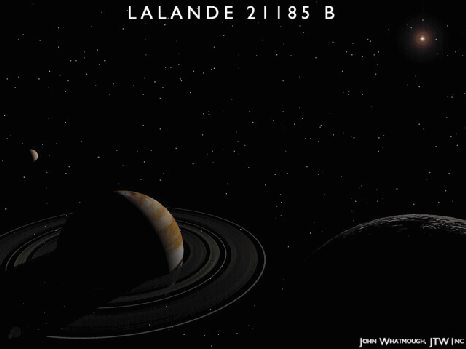Credit & Copyright: John Whatmough,
Extrasolar Visions
Explanation:
What's the closest
extrasolar planetary system?
It may well be planets of the dim red dwarf star
cataloged as Lalande 21185 -- a mere 8 light years distant.
This star is too faint
to be seen by the naked eye and its planets have not been
imaged directly. Instead,
their presence is inferred by a long series
of telescopic observations, tracking
the star as it wiggles and wobbles in mutual gravitational response to
the masses of its orbiting planets.
Our own planetary system would be detectable by such a technique ...
Using data obtained from frequent observations of this star over the last
50 years,
University of Pitsburgh astronomer
George Gatewood recently announced that much of
Lalande 21185's wobble is most likely due to
an unseen planet with approximately
90% of the mass of Jupiter and an orbital period of 5.8 years.
His work also indicates that
a second and possibly third planet of similar mass could
well be present in the system.
Massive planets orbiting a red dwarf star would
be very different from the Earth -- as illustrated in
this artist's vision of a Jupiter-sized
planet with rings and moons lit by a cool, dim sun.
Nevertheless, the existence of
a planetary system
so near our own suggests the
intriguing possibility that planets are common in our galaxy.
Authors & editors:
Robert Nemiroff
(MTU) &
Jerry Bonnell
(USRA)
NASA Web Site Statements, Warnings,
and Disclaimers
NASA Official: Jay Norris.
Specific
rights apply.
A service of:
LHEA at
NASA /
GSFC
& Michigan Tech. U.
Based on Astronomy Picture
Of the Day
